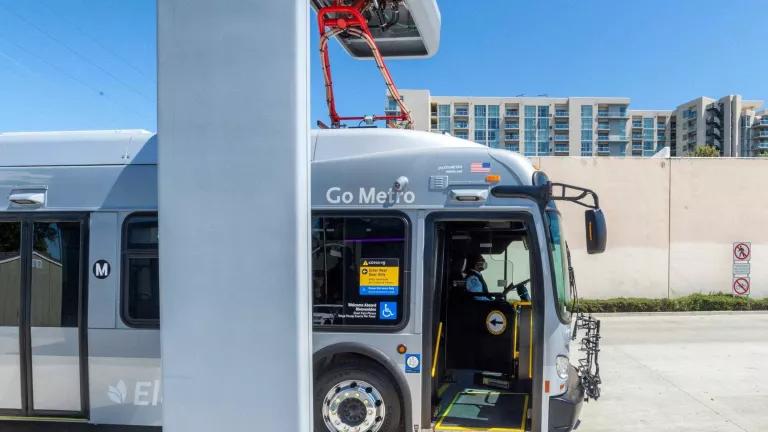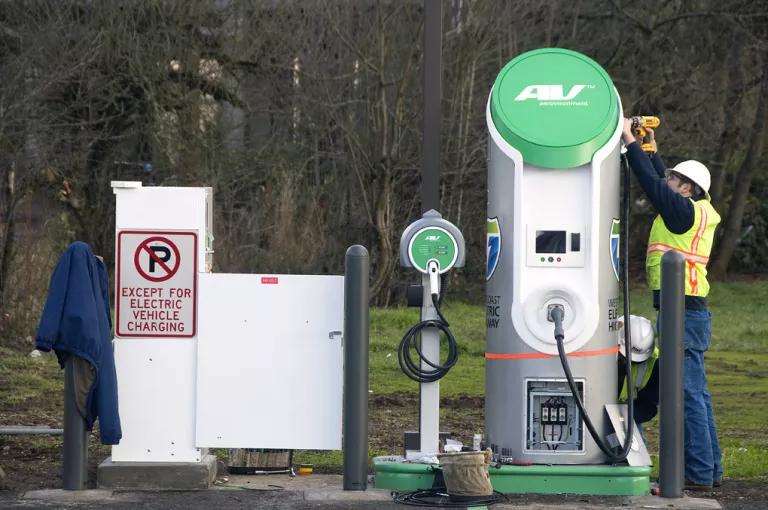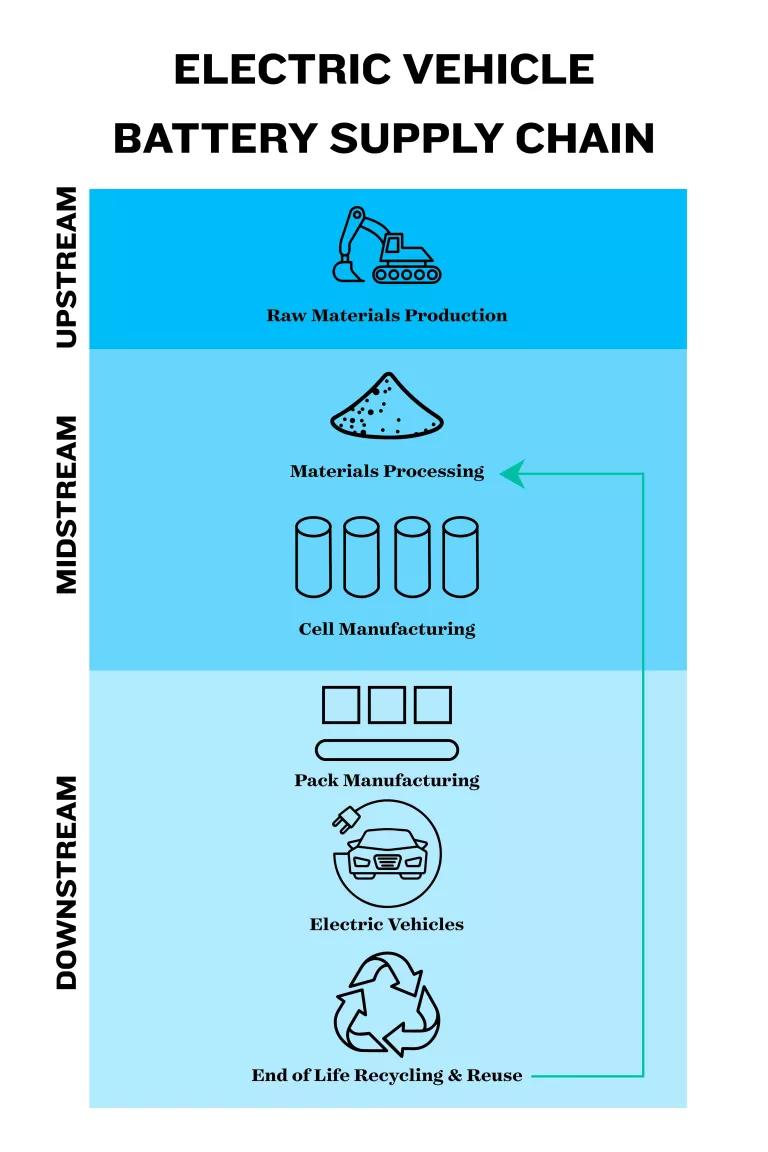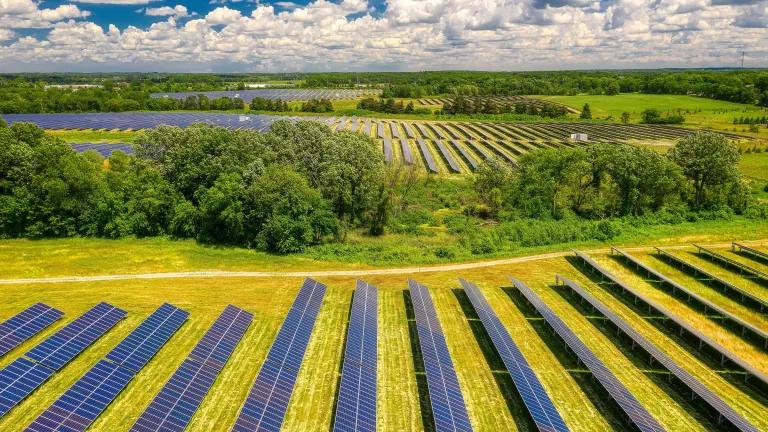Accelerating Toward a Zero Pollution Transportation Future
This year saw historic announcements to invest and build electric vehicles and infrastructure. Now is the time to lock-in deployment and investments through standards.

An electric bus on the Metro G Line recharges at the Metro Orange Line Busway in the San Fernando Valley, Los Angeles County, California, on July 27, 2020.
This blog is part of NRDC’s Year-End Series Reviewing 2022 Climate & Clean Energy Developments
The United States is now poised to attract hundreds of billions in private investments in transportation electrification, for the first time catching up in the global competition with the European Union and China. Those investments are being spurred by not only growing consumer demand for electric vehicles (EV), but the Biden Administration’s move to tighten federal clean car standards, Biden and Congress collaborating on the largest U.S. investments in EV manufacturing and tax credits under the Inflation Reduction Act, and the industry seeing EV technologies outcompete in terms of costs and performance thanks to technological advancements. These record investments in a new, cleaner future will boost the economy, create jobs in communities across the country, and allow millions to break free from the rollercoaster of gasoline prices.
Let’s go through some of the key areas of progress to celebrate from 2022, as well as the opportunities and headwinds expected for the new year.
Inflation Reduction Act (IRA)
The historic passage of the IRA in August will provide $369 billion in strategic investments over the next decade, including major investments in clean transportation that will reduce pain at the pump together with vehicle pollution. The Act does so by providing lower and middle-income households with tax credits to transition to used or new zero emission electric vehicles (EV), together with business owners of commercial trucks, and bus fleets providing services to schools and for public transit. The law’s investments also provide generous tax credits for the installation of charging stations to help ensure everyone has a place to plug-in. Finally, the bill also includes investments for Neighborhood Access and Equity Grants program to help right the historic racial inequities of our highway system by providing funding to tear down highways that divided disadvantaged neighborhoods, build new connecting infrastructure, and help mitigate the damage.
Collectively, these investments will help to strengthen American leadership and competitiveness on clean cars and trucks by supporting U.S. manufacturing and energy security. The U.S. is now poised to catch up and surpass Europe and China in the global EV race through the help of production tax credits, grants, and loans for new or retooled domestic facilities building batteries and electric vehicles. But effective implementation by federal agencies and their state counterparts will be critical. Policymakers will need to lean-in to ensure they maximize access to the IRA provisions – given the numerous requirements - in particular for those communities disproportionally harmed by pollution including environmental justice and communities of color.

MacKenzie Deltart working on the 2022 Ford F-150 Lightning Pro electric pickup truck production line at the Electric Vehicle Center on the grounds of the Ford River Rouge complex in Dearborn, Michigan.
States Set the Bar for Zero-Emission Vehicles
As my colleague Kathy Harris writes, states are setting a new bar for the deployment of zero-emission vehicles through clean car and clean truck standards . California solidified its clean transportation leadership by adopting first-in the-nation standards that year-over-year move the state towards 100% new zero-emission vehicle sales by 2035 through the Advanced Clean Cars II (ACC) program. A host of other states – from Washington, Oregon, Vermont, New York, Massachusetts – are moving forward with adoption of their own ACC II program together with numerous other states now considering adopting programs in 2023. These rules will help to accelerate the transition towards zero emission vehicles that is already underway, all while providing health, air quality, climate, and economic benefits to the state and drivers. But state leadership will be critical as the oil and fossil fuel industry is fighting to keep Americans hooked on oil.
This holiday season, traffic from commercial shipping and deliveries is skyrocketing. Numerous states are also looking to adopt clean truck programs, such as the Advanced Clean Trucks program, requiring manufacturers to deliver and sell more zero-emitting electric trucks to commercial fleets over time, helping address a major source of pollution. 2023 with be the year that states such as Colorado, North Carolina, and numerous other states will likely consider whether they will join six other states - New Jersey, New York, Oregon, Washington, Massachusetts, and California - in becoming a clean trucks state. As my colleague Patricio Portillo describes: policymakers in 2023 will need to decide whether they side with the myths being pushed by the Engine Manufacturing Association in opposing these critical vehicle standards or side with the frontline community members, public health organizations, labor, clean vehicles industry, science-based organizations and many other supporters of standards.

Federal Clean Vehicle Rules Remain Critical
While the federal investments were historic and necessary, they alone won’t be enough to ensure that the U.S. is on target to hitting its emissions reduction goals by the end of the decade. To “lock-in” the hundreds of billions in announced U.S. investments in transportation electrification from the private sector, and make them real and not simply hype, regulatory certainty for the market is needed. Luckily, there is tremendous opportunity that exists to pair IRA’s historic public investments with strong federal clean cars, clean trucks, and fuel economy standards, so that we will ensure that the U.S. locks-in additional private investments and is well on its way to achieving these necessary reductions and protecting public health. If we don’t, those investments will be shifted to Europe and Asia.
To continue making progress in reducing climate and health-harming pollutants, as well as overreliance on petroleum, the next round of federal clean car and clean truck standards expected to begin in 2023 must put the country on a path to a zero-pollution fleet. Despite vehicle emission and fuel economy standards being strengthened recently by the U.S. Environmental Protection Agency and the Department of Transportation, respectively, the latest fuel economy report shows that automakers’ shift to selling larger vehicles are offsetting both emission and efficiency gains. For this reason and more, it is important that EPA and NHTSA ensure standards going forward can’t be gamed, and that the agencies enact the strongest standards possible that put people and public health before polluters. As my colleague Britt Carmon wrote, there is still a lot more to do to move the needle on vehicle emission standards.

Source Raymond Clark Images
Putting Charging Stations in Every Neighborhood
Thanks to $7.5 billion in federal grants in the Infrastructure Investment and Jobs Act together with tax credits under IRA worth up to 30% of the cost of charging infrastructure and installation in homes and at businesses, President Biden campaign goal to deploy 500,000 EV charging stations across the country by 2030 can likely be not only met, but exceeded. In addition, complementary private and state investments are helping increase access to stations. Utility investments in electric transportation programs, including charging stations, have also been a key driver to exceed Biden’s goals, with now over $3.5 billion in utility investments approved across 34 states.
The National EV Charging Initiative, which NRDC is a founding member of, held its first Summit in January with attendance by U.S. Department of Energy Secretary Jennifer Granholm, Commerce Secretary Gina Raimondo, the Deputy Secretaries of Transportation and Energy, along with other leading voices from the automotive, EV charging, and electric industries, and other key stakeholders and equity groups. The event was attended by 900 people and led to commitments in support of expanding infrastructure investments and access. Regional summits are now being held, including a Western Summit with Governors Jay Inslee (WA), Jared Polis (CO), Secretary Granholm, together with other state representatives, CEOs, and EV stakeholders.
States have an enormous opportunity to take action in 2023 to ensure that investments in the electric grid and charging station deployment keeps pace with EV sales. For example, as my colleague Miles Muller describes: California recently adopted a new law that will help streamline strategic grid planning and investments needed to accommodate widespread EV deployment. When integrated into the grid the right way, electric vehicles can improve grid reliability and help drive electricity rates down for all customers as my colleague Max Baumhefner describes here.

A worker assembling an electric vehicle charging station along the West Coast Electric Highway in Cottage Grove, Lane County, Oregon.
Charging Forward to Green the U.S. Postal Service
Additionally, over the past year, NRDC and our partners saw a number of our other advocacy efforts prove victorious, including our efforts in pushing back against the U.S. Postal Service’s dangerous procurement plan to make 90% of its new fleet of 165,000 vehicles gasoline fueled. Thanks to engagement by NRDC and our allies – including the delivery of over 500,000 petitions against this action and other major actions – the agency announced that it would conduct a supplementary environmental review to assess the true costs of its plan and that it would make at least 40% of its new delivery fleet electric. While this was a great win, NRDC and our allies will continue to urge the USPS to amend its plan and will press the agency to electrify more of its fleet—a commitment that will pay dividends for decades and deliver cleaner air for many communities.

Delivery trucks parked at a USPS mail handling facility in Waltham, Massachusetts.
Building Batteries Better
The growth in demand for EVs is spurring the development of a large-scale battery manufacturing industry in the U.S. – an industry that has for the past three decades largely been based in Asia.
But building batteries better in the U.S. will also mean addressing supply chain challenges and sourcing materials sustainably. As my colleague Jordan Brinn wrote regarding supply chains for EVs, investments federally provide an opportunity to enact strong due diligence standards, including provisions minimizing harms to the environment and to Indigenous communities from mining. It also provides another reason and opportunity to prove mining and land use regulations, including through reforms to the Mining Law of 1872. Investing in a circular economy that can reuse and recycle batteries can also increase supply while reducing the need for new materials. Redwood Materials partners with auto manufacturers like Tesla, Ford, and Volvo to ensure material recovery rates above 90% at their electric vehicle battery recycling facility in Nevada. The technology to create a circular economy is available – we need strategic funding implementation and good policies to make it happen.

Electric Vehicle Battery Supply Chain Phases
Infographic by Jessica Russo: https://www.jessicaannarusso.com/ Source Image by the U.S. Department of Energy: https://www.energy.gov/sites/default/files/2021-06/FCAB%20National%20Blueprint%20Lithium%20Batteries%200621_0.pdf
Even More to Come
As you can see from the tremendous progress over the past year, a zero-pollution electric vehicle future is absolutely feasible. EV sales are on pace to hit record levels in the U.S. in 2022 – with sale levels 3x higher compared to just two years ago. Investments in plugs to charge electric vehicles also grew across the country – with 147,000 publicly-available plugs now available across 57,000 locations. It’s no time to rest, though. 2023 holds promise for accelerating the transition to clean vehicles even faster. Let’s keep the momentum going.




